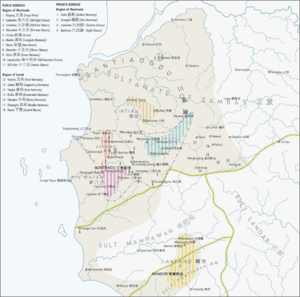Kongsi republic facts for kids
The kongsi republics were unique self-governing areas in Borneo. They were formed by groups of Chinese miners called kongsis. By the mid-1800s, these kongsi republics controlled much of western Borneo. The three biggest ones were the Lanfang Republic, the Heshun Confederation, and the Santiaogou Republic.
These kongsis were different from regular businesses. They were like small countries that controlled their own land. This made them stand out from the local sultanates, which ruled people but not always the land itself.
The kongsi republics often competed with the Dutch for control of Borneo. This led to three Kongsi Wars between 1822 and 1885. The Dutch eventually won, and the kongsi lands became part of the Dutch colonial state.
The kongsi federations were run by their members through a system called direct democracy. This means people voted directly on decisions. Early writers called them "republics." Today, experts still discuss if they were like Western-style republics or a unique Chinese way of governing themselves.
Contents
History of the Kongsi Republics
Kongsis first started as business groups where members shared money and profits. They appeared in the late 1700s when Chinese people moved to Southeast Asia. These groups grew with the Chinese gold mining industry. They were based on old Chinese ideas of brotherhood and working together. Many kongsis began as small partnerships called huis. When a hui grew very large, with hundreds or thousands of members, it became known as a kongsi.
Not many records exist about the very first Chinese mining groups. We know that gold mines were set up in 1779 around Landak Regency, but we don't know who worked there.
As old mining spots ran out, miners moved to new areas. This caused bigger kongsis to join together or take over smaller ones. The Fosjoen Federation, for example, was formed in 1776. Fourteen smaller kongsis near Monterado joined to create this single federation.
Soon after, Luo Fangbo started the Lanfang Republic in 1777. Luo came from Guangdong, China, with other migrants in 1772. Lanfang grew quickly because it traded a lot with the Pontianak Sultanate.
The kongsi republics controlled important port and inland towns. This allowed them to trade goods without problems from the Dutch or Malay rulers nearby. Chinese kongsis were connected to towns like Singkawang, Pemangkat, and Bengkayang Regency. These towns had businesses for miners, like pharmacies, bakeries, restaurants, barber shops, and schools.
The West Borneo Kongsi Republics were also important for the founding of modern Singapore. They used Singapore to avoid Dutch trade rules. They exported gold, sea products, and forest products through Singapore. The trade between Borneo and British Singapore was even bigger than the trade the Dutch had in Borneo.
The Kongsi Wars
The Kongsi Wars were three separate conflicts between the Dutch and the kongsi federations. They happened in 1822–1824, 1850–1854, and 1884–1885.
- The first war was the Expedition to the West Coast of Borneo (1822–24).
- The second was the Expedition against the Chinese in Montrado (1850–54).
- The third was the Chinese uprising in Mandor, Borneo (1884–85).
Most kongsi republics were taken apart by the Dutch after the Second Kongsi War. The Lanfang Republic was the last one to survive. They made a deal with the Dutch to remain a self-governing state within the Dutch East Indies. Lanfang could still choose its own leaders, but the Dutch had to approve them.
By the mid-1800s, the Dutch wanted to limit Lanfang's power. The Third Kongsi War, a Chinese rebellion against the Dutch in 1884–1885, ended Lanfang's independence. Lanfang's land was then divided among Pontianak, Mempawah, and Landak. The Chinese people living there became subjects of the Dutch government. They also had to pay taxes to local leaders.
How the Kongsi Republics Were Governed
The main governing body of the kongsi republics was the assembly hall (宗堂 zongtang). This was a meeting of representatives from the different kongsi mining communities. The assembly hall made laws and carried out decisions.
In the Heshun Confederation, for example, the representatives in the assembly hall were chosen every four months.
People in the 1800s often praised how democratic the kongsi federations were. Historians at that time called them republics. A Dutch expert named Jan Jakob Maria de Groot thought they were "village republics" that had a "spirit of democracy." He said that the word "kongsi" itself means "administration of something that is for everyone." For these political groups, it meant "an organization for governing the republic."
Some historians today point out that comparing kongsis only to Western democracies might not show their full story. They agree that kongsis had elections, like Western democracies. But they also argue that kongsis were a unique Chinese form of democracy that grew on its own. It's important to remember that in the 1800s, a "republic" simply meant any political system without a king or queen who inherited power.
List of Known Kongsi Organizations


